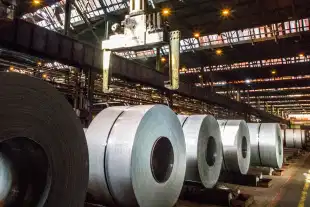Infrastructure
India's Steel Minister Calls For Increase In Use Of Vehicle Scrap In Steel Production To Cut Carbon Emissions
Ankit Saxena
Jun 09, 2023, 12:31 PM | Updated 01:31 PM IST
Save & read from anywhere!
Bookmark stories for easy access on any device or the Swarajya app.


On Wednesday, Jyotiraditya Scindia, the Minister for Steel, stated that in order to decrease carbon emissions, India needs to increase the use of vehicle scrap in steel production.
Scindia also addressed concerns over the impacts on domestic steel industry's production, from imports.
The minister highlighted that despite import threats, the domestic steel sector remains a net exporter. The imported steel tends to be specialised or offers a pricing advantage, reports Economic Times.
China's large manufacturing capacity remains idle due to their economy not growing at the projected rate despite having been put in place, he said.
India's steel production reportedly stands at 126 million tonnes, with only 9 million tonnes exported while imports are restricted to about 6 million tonnes.
Scindia explained that imported steel is not of high volume but instead more specialised than what is produced in India.
While the domestic steel industry is exporting and meeting local requirement, the global push for decarbonising comes across as a challenge.
Decarbonising Steel Production In India
The National Steel Policy 2017 outlines the need for India to double its existing steel capacity to 300 million tonnes (mt). However, manufacturers face complications due to the lack of consensus on what should be classified as 'Green Steel'.
According to Scindia, the definition of green steel has to be established on an international basis, but in the meantime, domestic steel firms should focus on reducing their carbon emissions.
He emphasised on the need to recycle end of life vehicles (ELVs) for making steel, as only 25 mt of scrap is currently used for this purpose in India. He suggested increasing this amount owing to the reserve of ELVs in both public and private sectors.
Green steel is produced without the use of fossil fuels, with the aim of reducing carbon emissions.
As one of the methods for steel produced through processes that do not emit carbon dioxide — includes using hydrogen as the ‘reducing agent’ (remover of oxygen) in steel production.
In other words, iron ore is basically iron oxide and hydrogen is used to pull oxygen away from iron oxide, leaving pure iron behind — to which a little carbon is added to make steel, according to The Hindu BL report.
Right now, carbon, in the form of coke, has been used for pulling away oxygen.
While most steelmakers have committed to being net zero on emissions over a period of time, the process will entail significant costs.
Following this, major steel manufacturers in India have also previously requested assistance from the government in their pursuit to manufacture green steel, as they anticipate that the additional expenses incurred in production with this transition will not be absorbed by consumers.





